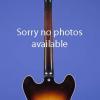Rare Single-Cut Duo Jet with Filter'Tron Pickups
This 13 1/4-inch-wide guitar weighs just 7.50 lbs. and has a nice, fat nut width of just over 1 11/16 inches and a scale length of 24 1/2 inches. Chambered mahogany body with three-ply binding, pressed arched top with Black Nitron finish, one-piece mahogany neck, and bound ebony fretboard with 22 frets plus zero fret and neo-classic inlaid pearloid thumbprint (half-moon) position markers. Headstock with inlaid pearl Gretsch "T-roof" logo. Individual open-back Grover StaTite tuners with oval metal buttons. Two patent number Filter'Tron pickups with clear plastic surrounds and outputs of 3.96k and 4.08k. Clear Lucite pickguard painted white from the underneath and engraved in black from the underneath with the Gretsch "T-roof" logo. Three controls (two volume on lower treble bout, one master volume on treble horn) plus two three-way tone selector switches on upper bass bout. "Arrow-through-G" knobs with cross-hatch pattern on sides. Original Space Control bridge on ebony base and and chrome cut-out "G-hole flat" tailpiece. Inside the control cavity on the back of the guitar is the orange and gray Gretsch label printed in black, with the model number ("6128") stamped in blue and the serial number ("39991") stamped in black. The switch control cover plate is engraved with the serial number ("39991"). This totally original guitar is in exceptionally fine (9.00) condition, with only a few minuscule marks on the edge of the guitar. Housed in the original Gretsch two-tone gray hardshell case with burgundy plush lining (8.75).
"In 1953 Gretsch launched its first solidbody, the $230 Duo Jet. In fact, while the guitar looked like a solid and certainly recalled the general outline and visuals of the $225 Gibson Les Paul, underneath things were somewhat different. At the time, Gibson used a sturdy sandwich of mahogany and maple for the Les Paul's body, while Fender used solid ash for its Telecaster. Gretsch, however, assembled the just-over-13-inch-wide body of the Duo Jet from several pieces of mahogany, incorporating a number of routed channels and pockets for cables and components, and adding a pressed arched top as a 'lid'. The most accurate description of Gretsch's new 'solid' guitar is probably 'semi-solid'. But in terms of its look, function, catalogue description and intended place in the market, the Duo Jet was in effect Gretsch's first solidbody electric guitar…Unusually, during its early years the new Duo Jet's body had a front covered in black plastic material, as used on some Gretsch drums. The guitar's control layout marked the start of Gretsch's fondness for positioning a master volume knob down on the cutaway bout rather than with the other controls…The Jet came with Gretsch's unique two-piece strap buttons -- an early take on the idea of locking strap buttons…The model also featured the Melita Synchro-Sonic bridge" (Tony Bacon, 50 Years of Gretsch Electrics, pp. 20-21).
George Harrison bought a 1957 Gretsch Duo Jet early in 1961. "Harrison used the Duo Jet throughout the group's rise to fame, only retiring it when he acquired a double-cutaway Gretsch Country Gentleman in summer 1963" (Tony Bacon, Electric Guitars: The Illustrated Encyclopedia, p. 164).
Translate:


